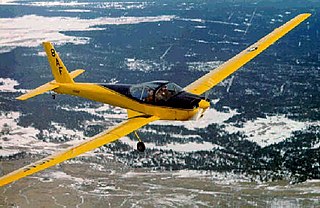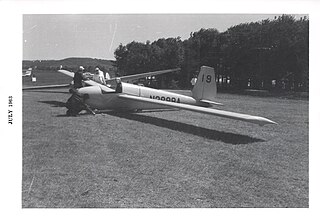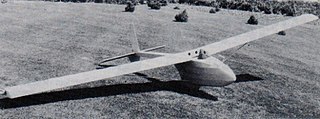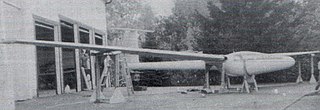
The Schempp-Hirth Cirrus is an Open Class glider built by Schempp-Hirth between 1967 and 1971 and by VTC until 1977. It was replaced by the Nimbus 2.

The ICA IS-29 was a sailplane built in Romania in the 1970s. The prefix IS comes from Iosif Șilimon, the Romanian IAR aeronautical engineer who designed it.

The Schweizer SGM 2-37 is a two-place, side-by-side, fixed gear, low wing motor glider.

The Schweizer SGS 1-29 is an American single-seat, mid-wing, experimental laminar flow airfoil glider built by Schweizer Aircraft of Elmira, New York.

The Schweizer SGS 1-35 is a United States 15 Meter Class, single-seat, mid-wing glider built by Schweizer Aircraft of Elmira, New York.

The Schweizer SGS 1-36 Sprite is a United States, single-seat, mid-wing glider built by Schweizer Aircraft of Elmira, New York.

The Glasflügel 604 is a high-wing, T-tailed, single seat, FAI Open Class glider that was designed and produced in West Germany by Glasflügel starting in 1970.
The Berkshire Concept 70, sometimes called simply the C-70, is an American, single seat, high-wing, 15 metre class competition glider that was designed by Arthur Zimmermann and produced by the Berkshire Manufacturing Corporation of Lake Swannanoa, New Jersey between 1971 and 1974.

The Laister LP-15 Nugget is an American single-seat, high-wing glider designed by Jack and Bill Laister for the FAI Standard Class. It first flew in 1971.

The Hall Vector 1 is an American high-wing, ultralight glider that was designed by Stan Hall for serious cross-country flights.
The Schreder HP-16 is an American mid-wing, single seat, V tailed, FAI Standard Class glider that was designed by Richard Schreder.

The Schreder HP-17 was an American mid-wing, V tailed, single seat, experimental glider designed by Richard Schreder to test a new airfoil section.
The Schreder HP-19 is an American, high-wing, T-tail, single seat glider designed by Richard Schreder.
The Gehrlein GP-1 is an American mid-wing, single seat FAI Standard Class glider that was designed by Jay and Rod Gehrlein and first flown in July 1968.

The Luenger Beta 1 was an American high-wing, single-seat, T-tailed FAI Open Class glider designed by Hans Luenger and Spud Kohler.
The Monaghan Osprey is an American mid-wing, single-seat, T-tailed, FAI Standard Class glider that was designed and constructed by Richard C. Monaghan of Pearblossom, California.

The FFA Diamant is a family of Swiss high-wing, T-tailed, single-seat, FAI Standard Class and FAI Open Class gliders that was designed by engineering students under supervision of Professor Rauscher at the ETH Zurich and manufactured by Flug- und Fahrzeugwerke Altenrhein AG (FFA) of Altenrhein, Switzerland.
The Whigham GW-5 is an American mid-wing, single seat, FAI Standard Class glider that was designed and constructed by Gene Whigham, a retired flight test engineer for Convair.

The Glasflügel 205 Club Libelle is a high wing, T-tailed, single seat glider that was designed and produced in West Germany by Glasflügel for club and rental use.

The Masak Scimitar was an American mid-wing, single-seat glider that was designed and constructed by Peter Masak. It first flew in 1995.


















